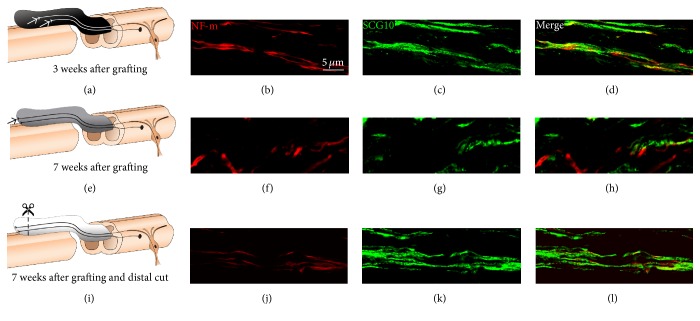Figure 1.
Experimental strategy and animal groups. All rats received a complete transection of the T12 spinal cord and immediate placement of PNGs of approximately 10 mm in length. (a) Group 1 rats received no further intervention and were euthanized at 3 weeks after grafting when the majority of axons are in active regeneration phase (arrows) and growing towards the distal end of the PNG. (b, c) show actively growing axons coimmunolabeled for NF-m and SCG10, respectively. (d) shows the merge of the two panels. (e) Group 2 rats received no further intervention and were euthanized at 7 weeks after grafting when axons had reached the unapposed distal end of the PNG (arrow) and stopped growing. (f, g) show axons “stalled” at the distal end that are coimmunolabeled for NF-m and for SCG10, respectively. (h) shows the merging of these panels. (i) Group 3 rats received a second intervention at 7 weeks after grafting when the distal end of the PNG was exposed and trimmed by 1 mm (dashed line) to reinjure the “stalled” axons (i). The rats were euthanized 2 weeks later. (j, k) show reinjured axons at the distal graft end coimmunolabeled for NF-m and SCG10. (l) shows the merged image. The colors (black, gray, or white) of PNGs in (a), (e), and (i) correspond to the color of bar graphs for 3 weeks, 7 weeks, and 7-week reinjury, respectively, in Figures 2, 3, and 4. Scale bar = 5 μm.

